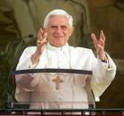|
Pope Benedict XVI- Audiences |

General
Audience
“The Wonder of my Being”
H.H.
Benedict XVI
December 28, 2005
www.zenit.org
Dear Brothers
and Sisters,
1. At this General
Audience on Wednesday of the Octave of Christmas, the liturgical
Feast of the Holy Innocents, let us resume our meditation on Psalm
139[138], proposed in the Liturgy of Vespers in two distinct stages.
After contemplating in the first part (cf. vv. 1-12) the omniscient
and omnipotent God, the Lord of being and history, this sapiential
hymn of intense beauty and deep feeling now focuses on the loftiest,
most marvelous reality of the entire universe: man, whose being is
described as a "wonder" of God (cf. v. 14).
Indeed, this topic
is deeply in tune with the Christmas atmosphere we are living in
these days in which we celebrate the great mystery of the Son of God
who became man, indeed, became a Child, for our salvation.
After pondering on
the gaze and presence of the Creator that sweeps across the whole
cosmic horizon, in the second part of the Psalm on which we are
meditating today God turns his loving gaze upon the human being,
whose full and complete beginning is reflected upon.
He is still an
"unformed substance" in his mother's womb: the Hebrew term used has
been understood by several biblical experts as referring to an
"embryo", described in that term as a small, oval, curled-up
reality, but on which God has already turned his benevolent and
loving eyes (cf. v. 16).
2. To describe the
divine action within the maternal womb, the Psalmist has recourse to
classical biblical images, comparing the productive cavity of the
mother to the "depths of the earth", that is, the constant vitality
of great mother earth (cf. v. 15).
First of all, there
is the symbol of the potter and of the sculptor who "fashions" and
moulds his artistic creation, his masterpiece, just as it is said
about the creation of man in the Book of Genesis: "the Lord God
formed man out of the clay of the ground" (Gn 2: 7).
Then there is a
"textile" symbol that evokes the delicacy of the skin, the flesh,
the nerves, "threaded" onto the bony skeleton. Job also recalled
forcefully these and other images to exalt that masterpiece which
the human being is, despite being battered and bruised by
suffering: "Your hands have formed me and fashioned me.... Remember
that you fashioned me from clay...! Did you not pour me out as milk
and thicken me like cheese? With skin and flesh you clothed me, with
bones and sinews knit me together” (Jb 10: 8-11).
3. The idea in our
Psalm that God already sees the entire future of that embryo, still
an "unformed substance", is extremely powerful. The days which that
creature will live and fill with deeds throughout his earthly
existence are already written in the Lord's book of life.
Thus, once again
the transcendent greatness of divine knowledge emerges, embracing
not only humanity's past and present but also the span, still
hidden, of the future. However, the greatness of this little unborn
human creature, formed by God's hands and surrounded by his love,
also appears: a biblical tribute to the human being from the first
moment of his existence.
Let us now entrust
ourselves to the reflection that St Gregory the Great in his
Homilies on Ezekiel has interwoven with the sentence of the
Psalm on which we commented earlier: "Your eyes beheld my unformed
substance; in your book were written every one of them [my days]"
(v. 16). On those words the Pontiff and Father of the Church
composed an original and delicate meditation concerning all those in
the Christian Community who falter on their spiritual journey.
And he says that
those who are weak in faith and in Christian life are part of the
architecture of the Church. "They are nonetheless added... by virtue
of good will. It is true, they are imperfect and little, yet as far
as they are able to understand, they love God and their neighbour
and do not neglect to do all the good that they can. Even if they do
not yet attain spiritual gifts so as to open their soul to perfect
action and ardent contemplation, yet they do not fall behind in love
of God and neighbour, to the extent that they can comprehend it.
"Therefore, it
happens that they too contribute to building the Church because,
although their position is less important, although they lag behind
in teaching, prophecy, the grace of miracles and complete distaste
for the world, yet they are based on foundations of awe and love, in
which they find their solidity" (2, 3, 12-13, Opere di Gregorio
Magno, III/2, Rome, 1993, pp. 79, 81).
St Gregory's
message, therefore, becomes a great consolation to all of us who
often struggle wearily along on the path of spiritual and ecclesial
life. The Lord knows us and surrounds us all with his love.
[To special
groups:]
I am pleased to
welcome the English-speaking pilgrims present at this Audience,
especially those from Japan and the United States of America. Upon
all of you I invoke the Blessings of this Christmas Season.
I also greet the
young people, the sick and the newly-weds. May the
light of Christ that shone upon humanity on Christmas Night shine
upon each one of you, dear friends, and guide you in the effort to
give a courageous Christian witness.
Lastly, I join in
the memory that associates in these days the beloved peoples struck
a year ago by the tsunami that claimed countless human lives
and caused immense environmental damage. Let us pray to the Lord for
them and for everyone, also in other regions of the world, who have
suffered natural disasters and are awaiting our practical and
effective solidarity.
© Copyright 2005 -- Libreria Editrice Vaticana
This page is the work of the Servants of the Pierced Hearts of Jesus and
Mary